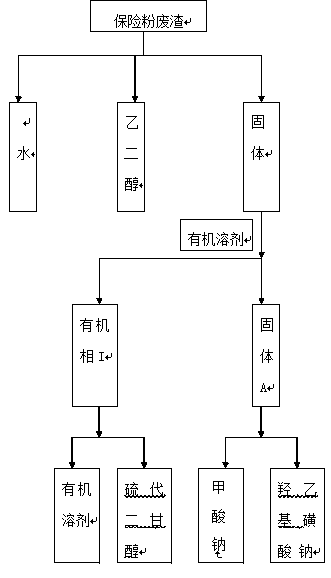Comprehensive utilization method of sodium hydrosulfite waste residue
A technology of hydrosulfite and waste residue, applied in chemical instruments and methods, preparation of hydroxyl compounds, preparation of organic compounds, etc., can solve the problems of failure to comprehensively utilize organic substances and reduce the amount of waste residue
- Summary
- Abstract
- Description
- Claims
- Application Information
AI Technical Summary
Problems solved by technology
Method used
Image
Examples
example 1
[0015] Example 1: Weigh 1000g of sodium hydrosulfite waste residue and put it into a vacuum still, turn on the vacuum pump, adjust the vacuum degree to about 2000Pa, control the heating temperature of the oil bath to about 80°C, complete the distillation of water in 3 hours, and obtain a water quality of 98g. Close the water receiving tank, open the ethylene glycol receiving tank, adjust the vacuum to 600Pa, raise the heating temperature to 100°C, and distill to obtain colorless ethylene glycol. The quality of the obtained ethylene glycol is 100g, and the purity is 99.5%.
[0016] Take 1500 ml of isopropanol: acetone mixed organic solvent with a volume ratio of 3:1 to wash the waste residue from the removal of water and ethylene glycol in the previous step. The number of washings is 4 times, and the washing temperature is 25-30°C. Filtration obtains solid A498g, accounts for 50% of waste residue total amount. The filtrates were combined to give the organic phase I.
[0017] T...
example 2
[0019] Example 2: Weigh 1000g of sodium hydrosulfite waste residue and put it into a vacuum still, turn on the vacuum pump, adjust the vacuum degree to about 2000Pa, control the heating temperature of the oil bath to about 100°C, and distill water in 1 hour to obtain a water quality of 97.5g. Close the water receiving tank, open the ethylene glycol receiving tank, adjust the vacuum to 600Pa, raise the heating temperature to 120°C, and distill to obtain colorless ethylene glycol. The quality of the obtained ethylene glycol is 101g, and the purity is 99%.
[0020] Take 1500 ml of isopropanol: acetone mixed organic solvent with a volume ratio of 2:1 to wash the waste residue removed from water and ethylene glycol in the previous step. The amount of mixed organic solvent used is 3 times the quality of the waste residue, and the number of washings is 3 times, the washing temperature is 25-30°C. Filtration afforded solid A 495g. The filtrates were combined to give the organic phase...
PUM
 Login to View More
Login to View More Abstract
Description
Claims
Application Information
 Login to View More
Login to View More - R&D
- Intellectual Property
- Life Sciences
- Materials
- Tech Scout
- Unparalleled Data Quality
- Higher Quality Content
- 60% Fewer Hallucinations
Browse by: Latest US Patents, China's latest patents, Technical Efficacy Thesaurus, Application Domain, Technology Topic, Popular Technical Reports.
© 2025 PatSnap. All rights reserved.Legal|Privacy policy|Modern Slavery Act Transparency Statement|Sitemap|About US| Contact US: help@patsnap.com

